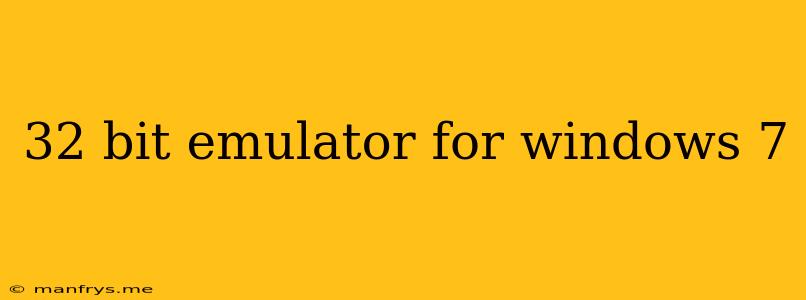Running 32-Bit Programs on Windows 7: A Guide
Windows 7 is a powerful operating system, but it's important to remember that it is a 64-bit operating system. This means that it's designed to run 64-bit applications, which are able to access more memory and process information more quickly than 32-bit applications. However, there may be times when you need to run a 32-bit program on your Windows 7 machine.
Why You Might Need a 32-Bit Program:
- Legacy Software: Older software may not have 64-bit versions available.
- Game Compatibility: Some older games may require a 32-bit environment to run.
- Hardware Drivers: Certain hardware components may only have 32-bit drivers available.
Do You Need an Emulator?
The good news is that you don't need a separate emulator to run 32-bit programs on Windows 7! Windows 7 has a built-in compatibility layer that allows you to run most 32-bit programs without any special configuration. This compatibility layer ensures that the 32-bit programs can access the necessary resources and run smoothly on your 64-bit system.
How to Run a 32-Bit Program on Windows 7:
- Locate the Program: Find the executable file for the 32-bit program you want to run.
- Right-Click and Select "Run as Administrator": This will ensure that the program has the necessary permissions to run properly.
- The Program Should Run: If the program is compatible with Windows 7, it should run without any issues.
Troubleshooting Tips:
- Check System Requirements: Ensure that the 32-bit program meets the minimum system requirements for Windows 7.
- Update Drivers: Outdated drivers may cause compatibility issues.
- Run in Compatibility Mode: Right-click the program's executable file, select "Properties", and then go to the "Compatibility" tab. Try running the program in a compatibility mode for a previous version of Windows.
- Seek Support: If you're still facing issues, consider seeking help from the program's developer or from online support communities.
Conclusion:
Running 32-bit programs on Windows 7 is typically a straightforward process. While you don't need an external emulator, you may need to troubleshoot some compatibility issues. Remember to check system requirements, update drivers, and consider running the program in compatibility mode if needed.
